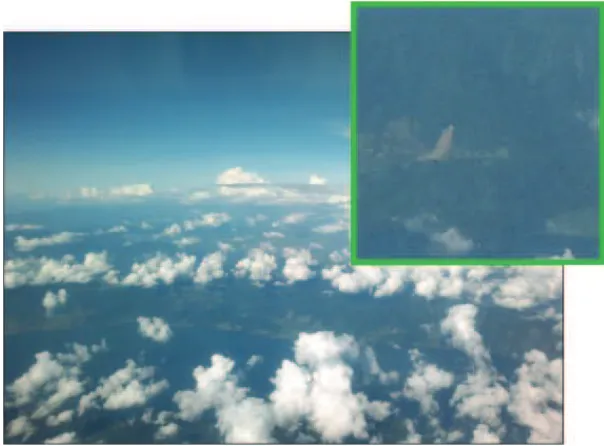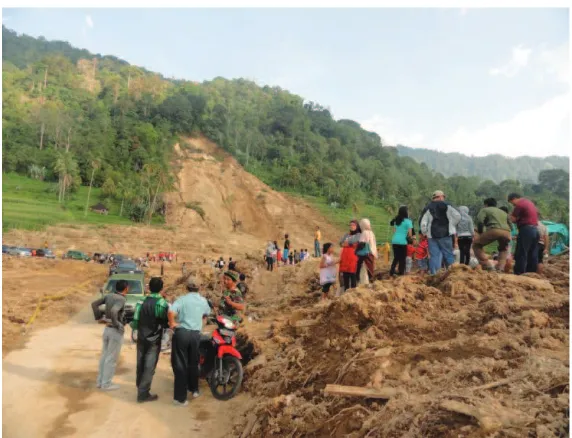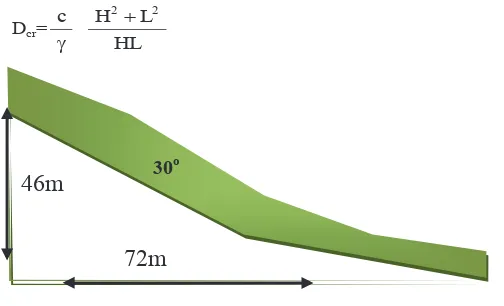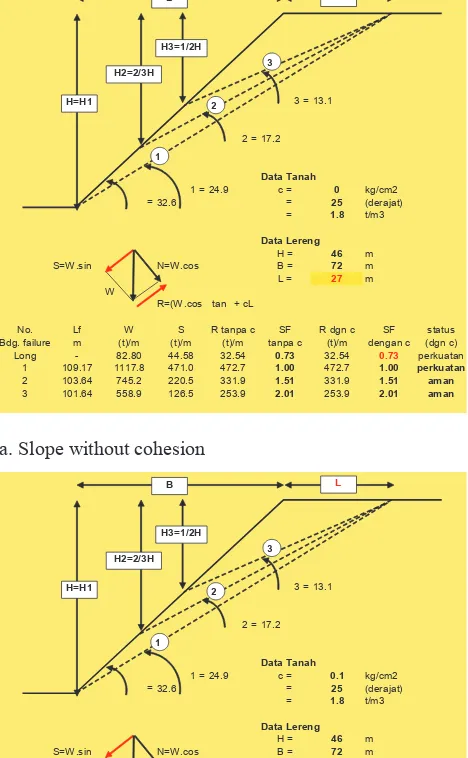The Second International Conference on Sustainable Infrastructure and
Built Environment – Bandung 19-20 November 2013
ISBN 978-979-98278-4-5
7. Geotechnical Engineering
Slope Stability Analysis Following
Maninjau Landslide 2013
Abdul Hakam, Febrin A Ismail, Fauzan, Bambang Istijono & Ricky Arnaldo
1
Disaster Studie Centre of Andalas University 2
Kampus Unand – Limau Manis, Padang
Email: [email protected]
Abstract. The Landslide in Maninjau 26-01-2013 that happened in the dawn has
taken the 22 lives. The location of landslide is in hill side of Maninjau Lake. The landslide it self might be triggered by the rain in several hours in the night. To determine the cause of the Padang landslide 2012, the field investigation was conducted. The physical and mechanical properties of the soil in the area are examined. The research of physical properties is especially useful for understanding the behaviour of soil in the change of water content. The type of soil that dominates the catchments area is fine grained soil. This type of soil will change the mechanical behaviour with the change of the water content. Using the test data, the slope stability is conducted to figure out the factor of safety the hill. It is concluded that the same phenomenon can be happened in surrounding area. It is suggested that the people together with the local government to install the early warning equipment in the typical areas.
Keywords: landslide, soil property, slope stability analysis.
Introduction
Landslides and similar phenimena in Weat Sumatra are named as Galodo. Through these natural disasters the people of West Sumatra (called Minangkabau) take the lessons for themselves that what they have done in the past that may cause disaster. They have the responsibility against the natural surroundings. So the past mistake should not be repeated again in the future.
The Landslide in Maninjau on 26-01-2013 happened in the dawn has taken the 22 lives. This Galodo happened in the hillside of Maninjau lake area.
Slope stability analysis following Maninjau Landslide 2013 399
7. Geotechnical Engineering
Figure 1. Location of Maninjau lake
Figure 2. Maninjau landslide spot
Metodologhy
400 A HAKAM, FEBRIN A I, FAUZAN, BAMBANG I & RICKY A
7. Geotechnical Engineering
soil samples then were taken into the laboratory for physical and mechanical parameters tests.
It is known that in the night before the disaster, it was rain in the surrounding area of Maninjau lake. It is predicted that the landslide of slopes in Maninjau is mainly triggered by the presence of intrusive water due to the rain. The tests of the soil samples were carried out also in associated with soil behavior related to its interaction with water. Then the experiment conducted on soil samples mainly are as follows:
a. Soil grain size distribution test: In general, the soil is classified into two main groups, those are fine-grained soil and coarse grained soil. The sieve test of soil is aimed to determine the distribution of the soil grain size that dominates in the soil structure of Maninjau landslide. The sieve test is performed using the series of sieves to separate the grains of the soil in certain sizes. The percentage of certain grain size of soil that passes through the sieves was plotted in a graph to determine the figure out the soil particle distribution. Based on this graph, the soil then can be classified in to either fine or coarse grained soils.
b. The Atterberg limits tests: These tests are aimed to obtain data of the water content in the soil that can change the consistency of the soil in the terms of plastic limit and liquid limit. In fact that if a soil has a moisture content that exceeds its liquid limit, then the soil mass can easily transforms from a solid form to a liquid form. The soil mass that has excessive water content in it can flow as the behavior of liquids. In nature, this flowing soil mass is usually move together with the other objects and is known as the mud flow or debris flow.
Slope stability analysis following Maninjau Landslide 2013 401
7. Geotechnical Engineering
d. The physical parameters tests: These tests are performed to obtain the values of the natural water content, the specific gravity and the unit weight of the soil. These parameters are required to identify soil type and also needed as the input data for the slope stability analysis.
The slope stability analyses then can be performed using the results of the soil parameters tests as the input data. The slope stability analyses are conducted with the variations of moisture conditions, that are using data from natural soil sampel and soaked sample. Based on the field survey that the actual landslide has a linear type of failure surface in slope. Then the slope stability analyses consider also by assuming the linear failure surface in the slope that has the same direction with the surface slope. The critical depths of failure surfaces in the slope can be determined from the stability analyses of the slope.
In order to suggest the remedial action of the slope, the critical depth of failure surface on the slopes must be determined. The critical depth is the depth of potential failure in slope that significantly affected by changes of the water content. Meanwhile the changes of water content for the uncovered slopes are strongly affected by the weather (rain and drought seasons). Since the cover of the slope has been opened by landslide, the best remedial method on the slope of the Maninjau landslide is the reforestation. The specific plants must be
402 A HAKAM, FEBRIN A I, FAUZAN, BAMBANG I & RICKY A
7. Geotechnical Engineering
Figure 3. Evacuation process
Results and discussion
Based on viasual investigation on field, the slope geometry on location of Maninjau Galodo is estimates as shown in Figure 4. The Maninjau sloope can be categorized as non-steep slope since the slopes have average angle less than 45 degrees.
Eventhough the actual location there are found many grained soil particles, but the behavior of the cohesive soil dominates the slope stability. It seems that during the landslide the soil mass were moving together in terms of mudflow. The laboratory test of the soil samples gave the results in erms of the physical and mechanical parameters as shown in Table 1.
Slope stability analysis following Maninjau Landslide 2013 403
7. Geotechnical Engineering
Figure 4. Post landslide condition
Table 1 The test results of soil samples 1 and 2.
S1 S2
Water content w 28.11 36.77 %
Unit weight g 1.79 1.85 t/m3
Spesific Gravity Gs 2.65 2.65
Gravel 4.03 3.17 %
Sand 14.57 39.87 %
LL 44.90 60.24 %
PL 34.14 31.27 %
PI 10.76 28.97 %
c 0.94 1.50 t/m2
f 32.28 24.85 º
c 1.05 2.06 t/m2
f 27.32 31.11 º
Sieve analysis
Atterberg's Limit
Direct Shear (soaked)
Direct Shear (wet)
Sample
Parameter Unit
Test name
404 A HAKAM, FEBRIN A I, FAUZAN, BAMBANG I & RICKY A
7. Geotechnical Engineering
The slope geometric and the average soil parameters obtained from tests are used to simulate the flat failure surface in slope stability analyses. The results show that the slopes are still in an actually location in a critical condition, with the lowest safety factor is less than 1.0 (Figure 6). While for the slope without cohesion the slope is more unstable.
Furthermore, to determine the critical depth of the slope failure surface by assuming to be parallel to the surface, the critical depth of failure is calculated as follows [3]:
(2)
Figure 5. Maninjau landslide geometry
The critical depth also calculated by assuming that the slope behaves completely dominated by the soil cohesion. The result shows the depth of the slope is 1.22m.
Based on the calculation above, in order to prevent the landslides in the hillside of Maninjau, the action of re-planting may be done. Replanting of slope in addition serves to create a beautiful landscape also to reduce the influence of weather on physical and mechanical parameters of the soil. Types of trees suitable to be planted is that having the root to reach the depth exceeding 1.22 m. Technically, in order to maintain safety in heavy rain conditions that can lead to a reduction in soil strength, the recommended tree roots is one and a half times that of the critical depth that about 1.8m from the ground surface.
Dcr=
HL L H
c 2+ 2
g
30o 46m
Slope stability analysis following Maninjau Landslide 2013 405
7. Geotechnical Engineering
a. Slope without cohesion
b. Slope with cohesion 0.1 kg/cm2
Figure 6. The value of the safety factor for the length of the different collapse
3 = 13.1 Long - 82.80 44.58 32.54 0.73 32.54 0.73 perkuatan
1 109.17 1117.8 471.0 472.7 1.00 472.7 1.00 perkuatan
2 103.64 745.2 220.5 331.9 1.51 331.9 1.51 aman
3 101.64 558.9 126.5 253.9 2.01 253.9 2.01 aman 3 Long - 82.80 44.58 32.54 0.73 33.54 0.75 perkuatan
1 109.17 1117.8 471.0 472.7 1.00 581.9 1.24 aman
2 103.64 745.2 220.5 331.9 1.51 435.6 1.98 aman
406 A HAKAM, FEBRIN A I, FAUZAN, BAMBANG I & RICKY A
7. Geotechnical Engineering Conclusions
The results of the study conducted in the Maninjau landslide - 2013 area showed that the soil is dominated by fine-grained soil. The soil in the landslide are has the shear resistance that can decrease as the water content increases. In normal condition, it can be concluded that the slope is not in stable condition, more over on wet condition the slope may become unstable and lead to landslide.
To prevent the disaster of the same event, then the slopes of Maninjau should be regreened by planting trees with strong and deep enough roots. To maintain the stability of slopes in the rain season, the planted trees technically advisable to have roots that can penetrate the soil to a depth of more than 1.8 meters from the ground surface.
References
[1] Skempton, A.W. , The Colloidal Activity of Clays, Proceedings, 3rd Int. Conf. Soil Mechanics and Foundation Engineering, London, Vol. 1 [2] Murthy, V N S., Geotechnical Engineering: Principles and Practice of
Soil Mechanics and Foundation Engineering, Marcel Dekker Inc, 2008 [3] Hakam, A, Stabilitas Lereng dan Dinding Penahan Tanah- Untuk




